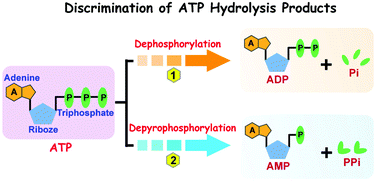A sensor array based on DNA-wrapped bimetallic zeolitic imidazolate frameworks for detection of ATP hydrolysis products†
Abstract
Most current biosensors were designed for the detection of individual analytes, or a group of chemically similar analytes. We reason that sensors designed to track both reactants and products might be useful for following chemical reactions. Adenosine triphosphate (ATP) is a key biomolecule that participates in various biochemical reactions, and its hydrolysis plays a fundamental role in life. ATP can be converted to adenosine diphosphate (ADP) and inorganic phosphate (Pi) via the dephosphorylation process. ATP can also be hydrolyzed to adenosine monophosphate (AMP) and pyrophosphate (PPi) through depyrophosphorylation, depending on where the bond is cleaved. The detection of ATP-related hydrolysates would enable a better understanding of the different reaction pathways with a high level of robustness and confidence. Herein, we prepared a fluorescent sensor array based on a series of bimetallic zeolite imidazole frameworks M/ZIF-8 (M = Ni, Mn, Cu) and ZIF-67 to discriminate ATP hydrolysis and detect ATP hydrolysis related analytes. A fluorescently-labeled DNA oligonucleotide was used for signaling. Interestingly, Cu/ZIF-8 exhibited an ultrahigh selectivity for recognizing pyrophosphate with a detection limit of 2.5 μM. Moreover, the practicality of this sensor array was demonstrated in fetal bovine serum, clearly discriminating ATP hydrolysis products.

- This article is part of the themed collection: 2022 Nanoscale HOT Article Collection


 Please wait while we load your content...
Please wait while we load your content...